![]()
| France | Côte d'Azur | 2000.10.27 - 11.10 |
Mediterranean Coast
For 13 days, we traveled along the Mediterranean coast between Menton at the Italian border and Cassis, a small harbor town east of Marseille.
Grasse
Between Chasteuil and our Gîte Rural rental in Nice, we stopped in Grasse to visit a friend's brother's family for the weekend. Time with a local family is the best introduction to local life. Masami learned recipes for aïoli, olive preparation, and red wine vinegar. Wes learned to play a form of boules called pétanque. We were taken to the Molinard perfumery, introduced to other friends in Nice, and fed fantastic Provençal food. It was a familial weekend we were grateful for.
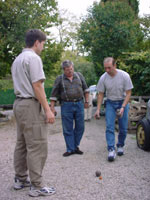 |
In pétanque, each player tries to throw his/her heavy steel ball closest to a small red ball. Here, Wes, Jean-Louis, and Vito verify the winner of the round. The players concentrate with utmost seriousness trying to accumulate 15 points first. |
 |
Olive trees grow all along the Mediterranean coast. Olive preparation time is a minimum of 40 days: 10 days soaking in water changed daily and 30 days soaking in water and salt without change. |
Nice
The drive from Grasse to the Gîte we rented near Nice in St. Isidore was a short 30 minutes. Pulling up to the house, we knew we made a good choice. The driveway was clear of leaves, the shrubs were trimmed, flowers bloomed along the clean steps leading up to the house, the clothes line had clothes pins, and olives on the trees were ready to be picked. The genuinely friendly owner showed us in. The interior, like the exterior, was a reflection of good taste. The combination of Provençal colored floor tile and wall paint blended well with comfortable furniture and wood paneled bedrooms. The kitchen was stocked with all the cook wear and serving dishes we needed. There were vases for flowers we bought at the Nice flower market, sufficient wardrobe space in the bedrooms, and a washing machine by the rear door. As an added bonus, the owner said we could pick all the olives we wanted. We were perfectly happy with our 10-day stay.
Gîte selection is guesswork. Gîte de France rates the Gîte we had in St. Isidore one cob out of five. Had this Gîte had a toaster, it would have rated two cobs. Add a dishwasher, and it would get three cobs. The special touches we were most satisfied with had no bearing on the number of cobs. It's possible to pay more money for a more highly rated Gîte and actually get one of poorer quality (like the 3 cob Gîte we rented in Cheval Blanc near Avignon).
Settled in St. Isidore, we drove into Nice. Knowing about the high tech area 20 km west in Sofia-Antipolis, we were anxious to gather as much information about this area that we prematurely decided could be a future home. Half a day in Nice was enough to discourage such thoughts. The congestion was exhausting. People were rushed. The Côte d'Azur beach we imagined was a paved walkway. Undoubtedly, our expectations of Nice surpassed reality.
Aside from overpopulation, Nice has its merits. Our new friends in Nice (friends of our Grasse friends) recommended the Café de Turin (tel: 04-9362-2952, located on Place Garibaldi) for "the best oysters in Nice". Indeed they were good. We were also directed to the Marché aux Fleurs where Masami found violets, mimosa, and roses to adorn our Gîte. Our Nice friends took us for a walk in the hills overlooking Nice and the harbor. Indeed, Nice from afar is a pretty sight.
 |
From the hills north of Nice, the city against the azure Mediterranean Sea is picturesque. A visit to the congested center of Nice, however, is exhausting. |
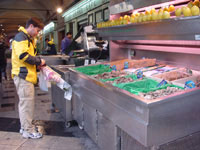 |
Wes inspects various sizes of oysters, muscles and sea urchins at Café Turin. Orders can be eaten at the restaurant or packed for take away. |
Menton to Cannes
Later in the week, our friend Tim arrived from London. Together, we toured the Cote d'Azur between Menton and Cannes and hiked in Mercantour National Park in the southern Alps near the Italian border.
With the exception of Èze, the drive along the coast from Menton to Cannes was unrewarding. The coastline is craggy in less populated areas and lined with concrete through the cities. Menton is little more than a border town and hardly worth a second visit. The city directly west of Menton is Monte Carlo - Monaco. Being a tax haven, Monaco exudes wealth. There appeared to be more Bentleys and Ferraris per city block than anyplace else we've been. Yet, the city looks little different than the unsightly high rise buildings lining the beaches of Waikiki, Hawaii. Tim and Wes wanted to try their luck at the Monte Carlo casino. Wes won FRF 400 (about US$60), his only income since leaving work in May. Tim wasn't as lucky, but he's employed.
Èze was the highlight of our trip along the coast. It's a cute chateau town perched atop a large coastal rock. Views of the Mediterranean Sea from the café terrace are beautiful.
Without the annual film festival, Cannes isn't much to look at. Our attention was drawn to two things: the huge aquariums in the casino with unusual species of fish, and ocean waves crashing over barriers and flooding the streets at the tail end of a storm - the same one that completely flooded parts of Britain and northern France.
West of Cannes is the prettiest part of the Côte d'Azur. Red rock rises from the sea to form the Massif de l'Estérel, an area with beaches, hiking, and gorgeous red rock formations.
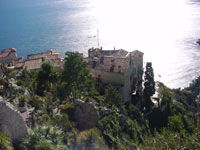 |
Looking at the Mediterranean Sea from the highest point in Èze. The stone structures are well maintained, and the narrow streets are closed to vehicles. |
Mercantour National Park
A mere 90 minute drive north of Nice is the Mercantour National Park. Mountain peaks close to 3000 meters in height form the border between France and Italy. Lonely Planet's Walking in France recommends a number of excellent hikes. Tim, Masami, and Wes chose the Lac de Trécolpas walk.
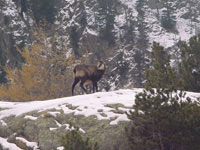 |
We saw dozens of chamois along the trail at higher elevations. |
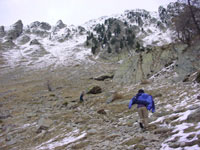 |
Tim and Masami continue up the hill towards Trécolpas Lake. Ice and snow coated the walking surface making some sections slippery. |
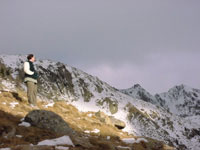 |
Above Trécolpas Lake, Tim looks towards the Italian border. |
Cassis
Cassis is a sleepy harbor town with good bouillabaisse and a fantastic hike called Les Calanques. The best walking map of the area is IGN 3615, Les Calanques de Marseille à Cassis. Rated hard by the Lonely Planet Walking in France guide, the hike is a moderately strenuous 6 hours with several steep ascents and descents not recommended for sufferers of vertigo. The most difficult section is an 80 meter vertical with a rock climbing grade that Wes estimates to be about 5.2. There are no ropes or ladders. Just hang onto the rocks with your hands and feet. Avoid this hike in wet weather because the worn rock surfaces become slippery.
The Les Calanques hike starts in the town of Morgiou, accessible by boat or taxi from Cassis. From Morgiou, the hike follows the coast to Cassis. About 20 trails from other directions intersect the Calanques trail, so it's best to carry a detailed walking map to avoid getting lost.
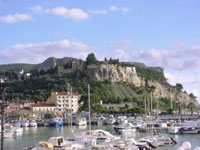 |
Cassis harbors sail boats and caters to tourists year-round. Restaurants and cafes circle the harbor. An outdoor market is held every Wednesday morning. |
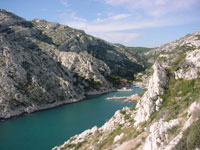 |
At the end of this inlet is Morgiou, the starting point of the Calanques hike. The trail leads along protruding white stone overlooking an impressively pristine Mediterranean coast. |
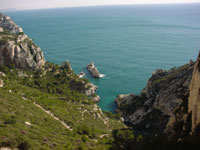 |
The Calanques walk continues along the shoreline for 6 hours. Hikes don't get much prettier than this! |
Copyright © 2000-2002 Wes and Masami Heiser. All rights reserved.